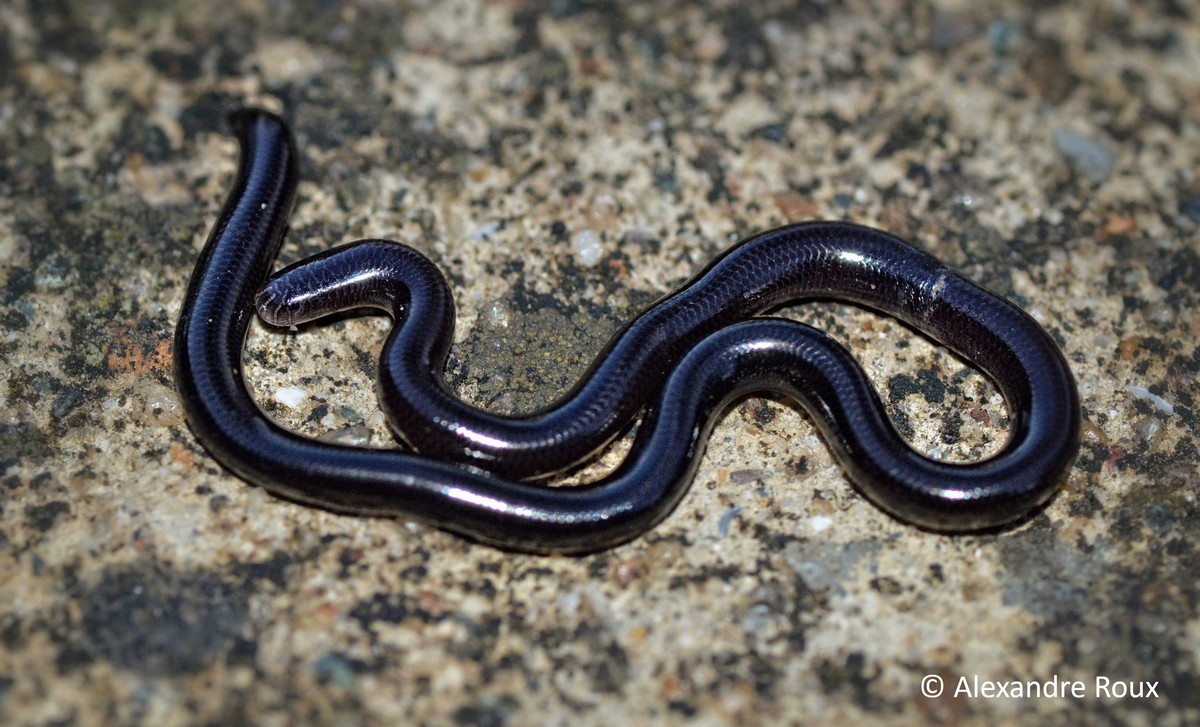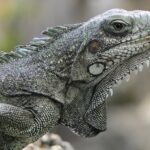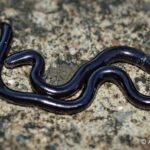
- Nom vernaculaire: Typhlops brame
- Nom scientifique : Indotyphlops braminus (Daudin, 1803)
- Nom local: Flowerpot Snake, Brahminy blindsnake, Bootlace Snake, Khorat Worm Snake, Khorat Blind Snake, Brahmanen-Wurmschlange, Khorat-Blindschlange, Culebrilla Ciega.
- Ordre : Typhlopidae
- Famille : Squamata
Description
Morphologie. Serpent non-venimeux de petite taille Le corps est fin et de couleur gris argenté, noir ou violet. La tête est peu différenciée du reste du corps, et les yeux apparaissent sous la forme de point noirs sous les écailles. La queue présente un éperon inoffensif à sa pointe. La face ventrale varie du gris au marron, et les écailles sont indifférenciées de celles du reste du corps. Les écailles sont petites, lisses et brillantes, et sont agencées sur 14 rangées le long du corps (Wallach, 2009).
Taille corporelle standard (longueur tête-tronc). 95 à 203 mm (Ota et al., 1991; Wallach, 2009; Das et al., 2016; Leets-Rodriguez et al., 2019).
Dimorphisme sexuel. Pas de dimorphisme sexuel (espèce unisexuée) (Ota et al., 1991).
Variations.
Confusion possible avec d’autres espèces. Dans les Caraïbes, la confusion est possible avec d’autres espèces de serpents endémiques de petite taille, tels que Tetracheilostoma bilineatum en Martinique, T. breuili à Sainte-Lucie et T. carlae à La Barbade. Ces trois espèces sont les plus petits serpents du monde (Breuil et al., 2009).
Distribution
Native. Asie: Pakistan (Balouch et al., 2016; Rais et al., 2021), Nepal (Bhattarai et al., 2018; Rawat et al., 2020), Bhoutan (Das et al., 2016), Inde (Manhas et al., 2018; Ingle et al., 2019; Ingle, 2020), Sri Lanka, Îles Andaman-et-Nicobar, Bangladesh (Ahsan et al., 2015), Myanmar, Thaïlande (Crane et al., 2018), Malaisie (Onn et al., 2009), Singapour, Laos, Cambodge (Grismer et al., 2008; Geissler et al., 2019), Vietnam (Ziegler et al., 2007), Chine, Hong Kong, Japon, Indonésie, Timor Leste, Philippines (Brown et al., 1996; Venturina et al., 2020).
Introduit. Europe: Madère, Canaries (Rato et al., 2015), Espagne (Zamora-Camacho et al., 2017), Baléares, Italie (Faraone et al., 2019; Paolino et al., 2019), Malte (Vella et al., 2020).
Asie: Arabie Saoudite (Burriel-Carranza et al., 2019), Oman (Carranza et al., 2018), Emirats Arabes Unis, Koweït, Liban, Irak, Iran (Rastegar-Pouyani et al., 2008; Afroosheh et al., 2010).
Afrique: Libye (Bauer et al., 2017), Égypte (Ibrahim, 2013), Mauritanie, Senegal, Côte d’Ivoire, Togo, Bénin, Cameroun, Gabon (Pauwels et al., 2004), République Centrafricaine (Chirio et Ineich, 2006), République Démocratique du Congo (Zassi-Boulou et al., 2004), Ouganda, Kenya, Somalie, Zimbabwe, Tanzanie, Zanzibar, Mozambique, Afrique du Sud, Madagascar (Andreone et al., 2003; D’Cruze et al., 2007; Gehring et al., 2010), Comores (Carretero et al., 2005; Hawlitschek et al., 2011), Mayotte, Réunion, Maurice, Rodrigues, Seychelles.
Océanie: Papouasie-Nouvelle-Guinée (Charlton et Nixon, 2020), Îles Salomon, Palaos, Nauru (McKenna et al., 2015), Australie (Parkin et al., 2021), Île Cocos, Île Christmas, Nouvelle Calédonie (De Pous et Dingemans, 2009), Vanuatu (Ineich, 2009), Fiji, Micronésie, Guam, Polynésie (Ineich et al., 2017).
Amérique: Hawaï, Californie, Arizona, Texas (Eversole et Daniel, 2020), Louisiane, Massachussetts, Connecticut, Georgie, Floride (Krysko et al., 2009; Atkinson et Townsend, 2012; Burke et Lieto, 2019), Mexique (Flores-Cobarrubias et al., 2012; Carbajal-Marquez et al., 2013, 2015; Carbajal-Marquez et Quintero-Diaz, 2016; Banuelos-Alamillo et Carbajal-Marquez, 2016; Gonzales-Sanchez et al., 2017; Lemos-Espinal et Smit, 2020), Guatemala, Bélize (Wallach, 2009), Nicaragua (Leets-Rodriguez et al., 2019), Salvador, Honduras (Wallach, 2009; McCranie, 2015), Colombie.
Caraïbes: Bahamas (Powell et Henderson, 2012), Cuba (Borroto-Paez et al., 2012), Îles Cayman (Powell et Henderson, 2012), Îles Turks et Caïques (Powell et Henderson, 2012), Sainte Croix (Powell et Henderson, 2012), Anguilla (Powell et Henderson, 2012), Saint Martin (Breuil et al., 2009; Lorvelec et al., 2007), Saint Barthélemy (Lorvelec et al., 2007), Saba (van den Burg, 2021), Saint Kitts (Powell et Henderson, 2012), Saint Eustache, Montserrat (Snyder et al., 2019), Guadeloupe (Breuil et al., 2009; Powell et Henderson, 2012; Lorvelec et al., 2016), Martinique, Barbade (Powell et Henderson, 2012); Saint Vincent et les Grenadines (Powell et Henderson, 2012).
Statut incertain. Taïwan (Lee et al., 2019)
Biologie et écologie
Habitat. Indotyhlops braminus est adapté à une grande diversité d’habitats naturels et anthropisés. Ce serpent fouisseur évolue dans les sols meubles et humides, la litière de feuilles, les troncs en décomposition, sous les rochers et autres débris. L’espèce est occasionnellement arboricole. I. braminus est souvent retrouvé dans les jardin et les pots de fleurs, les pépinières étant considérées comme le principal moyen de propagation de l’espèce hors de son aire de répartition (Breuil et al., 2009; Rato et al., 2015; Zamora-Camacho, 2017).
Régime alimentaire. Insectivore (œufs, larves et pupes de fourmis et termites) (Mizuno et Kojima, 2015).
Reproduction. Indotyphlops braminus est une espèce parthénogénétique, c’est-à-dire que les femelles pondent des œufs se développant sans la nécessité d’être fécondés.
Les femelle matures (environ 95 mm) pondent un à huit œufs (Ota et al., 1991). La période de ponte varie en fonction de la localité. Dans les régions sub-tropicale, elle a lieu à la fin de la saison humide (Vella et al., 2020).
Comportement. Lorsque menacée ou manipulée, l’espèce se défend en repoussant la menace à l’aide de la pointe de sa queue (inoffensive), et peut libérer un musc nauséabond produit via deux glandes à la base de la queue.
Impact et gestion des populations introduites
Impact. L’impact du Typhlops brame sur les écosystèmes natifs des régions d’introduction reste méconnu.
Gestion. Aucune mesure de contrôle ciblée n’est à ce jour établie dans les différentes régions d’introduction de l’espèce.
Bibliographie
- Afroosheh, M., Rastegar-Pouyani, N., Rajabizadeh, M., & Kami, H. G. (2010). The Brahminy Blind Snake, Ramphotyphlops braminus (Daudin, 1803), a newcomer to Iran (Ophidia: Typhlopidae). Zoology in the Middle East, 50, 135–137.
- Ahsan, M. F., Haidar, I. K. A., & Rahman, M. M. (2015). Status and diversity of snakes (Reptilia: Squamata: Serpentes) at the Chittagong University Campus in Chittagong, Bangladesh. Journal of Threatened Taxa, 7, 8159.
- Andreone, F., Glaw, F., Nussbaum, R. A., Raxworthy, C. J., Vences, M., & Randrianirina, J. E. (2003). The amphibians and reptiles of Nosy Be (NW Madagascar) and nearby islands: A case study of diversity and conservation of an insular fauna. Journal of Natural History, 37, 2119–2149.
- Atkinson, B. K., & Townsend, J. H. (2012). Ramphotyphlops braminus (Brahminy Blindsnake). USA: Florida. Herpetological Review, 43, 307–308.
- Balouch, S., Rais, M., Hussain, I., & Akram, A. (2016). Squamate diversity in different croplands of district Chakwal, Punjab, Pakistan. Journal of King Saud University – Science, 28, 255–260.
- Banuelos-Alamillo, J. A., & Carbajal-Marquez, R. A. (2016). Distribution notes. Indotyphlops braminus (Daudin, 1803). Mesoamerican Herpetology, 3, 204.
- Bauer, A. M., Deboer, J. C., & Taylor, D. J. (2017). Atlas of the Reptiles of Libya. Proceedings of the California Academy of Sciences, 64, 155–318.
- Bhattarai, S., Pokheral, C. P., Lamichhane, B. R., Regmi, U. R., Ram, A. K., & Subedi, N. (2018). Amphibians and reptiles of Parsa National Park, Nepal. Amphibian & Reptile Conservation, 12, 35–48.
- Borroto-Páez, R., Bosch, R. A., Fabres, B. A., & Garcia, O. A. (2012). Introduced amphibians and reptiles in the Cuban archipelago. Herpetological Conservation and Biology, 10, 985–1012.
- Breuil, M., Guiougou, F., Questel, K., & Ibéné, B. (2009). Modifications du peuplement herpétologique dans les Antilles françaises : disparitions et espèces allochtones. 2ème partie : Reptiles. Le Courrier de La Nature, 251, 36–43.
- Brown, R. M., Ferner, J. W., Sison, R. V., Gonzales, P. C., & Kennedy, R. S. (1996). Amphibians and Reptiles of the Zambales Mountains of Luzon Island, Republic of the Philippines. Herpetological Natural History, 4, 1–22.
- Burke, R., & Lieto, M. (2019). Tracking the spread of six invasive amphibians and reptiles using the geographic distribution records published in Herpetological Review. Herpetological Review, 50, 1–7.
- Burriel-Carranza, B., Tarroso, P., Els, J., Gardner, A., Soorae, P., Mohammed, A. A., … Carranza, S. (2019). An integrative assessment of the diversity, phylogeny, distribution, and conservation of the terrestrial reptiles (Sauropsida, Squamata) of the United Arab Emirates. PLoS ONE, 14.
- Carbajal-Marquez, R. A., Gonzalez-Quinanes, F., & Quintero-Diaz, G. E. (2015). Indotyphlops braminus (Brahminy Blindsnake). México: Chihuahua. Herptological Review, 46, 573.
- Carbajal-Marquez, R. A., & Quintero-Diaz, G. E. (2016). The herpetofauna of Aguascalientes, México. Revista Mexicana de Herptologia, 2, 1–30.
- Carbajal-Marquez, R. A., Valdez-villavicencio, J. H., & Chavez-Sanchez, T. (2013). Ramphotyphlops braminus (Brahminy Blind Snake). Mexico: Baja California Sur. Hepetological Review, 44, 110.
- Carranza, S., Xipell, M., Tarroso, P., Gardner, A., Arnold, E. N., Robinson, M. D., … Akhzami, S. N. Al. (2018). Diversity, distribution and conservation of the terrestrial reptiles of Oman (Sauropsida, Squamata). PLoS ONE, 13.
- Carretero, M. A., Harris, D. J., & Rocha, S. (2005). Recent observations of reptiles in the Comoro islands (Western Indian Ocean. Herpetological Bulletin, 91, 19–28.
- Charlton, T., & Nixon, D. (2020). Predation on the Common Blind Snake (Indotyphlops braminus; Daudin, 1803 ) by the Brown-headed Snake (Furina tristis; Günther, 1858 ) in Central Province, Papua New Guinea. The Captive & Field Herptology Journal, 4, 25–26.
- Chirio, L., & Ineich, I. (2006). Biogeography of the reptiles of the central african republic. African Journal of Herpetology, 55, 23–59.
- Crane, M. S., Strine, C. T., Knierim, T. K., Artchawakom, T., & Suwanwaree, P. (2018). Herptofaunal species abundance, richness, and diversity in a dry tropical forest and agricultural matrix at the Sakaerat Biosphere Reserve, Thailand. Herpetological Conservation and Biology, 13, 586–597.
- D’Cruze, N., Sabel, J., Green, K., Dawson, J., Gardner, C., Robinson, J., … Glaw, F. (2007). The first comprehensive survey of Amphibians and Reptiles at Montagne des Français, Madagascar. Herpetological Conservation and Biology, 2, 87–99.
- Das, A., Sharma, P., Surendran, H., Nath, A., Ghosh, S., Dutta, D., … Wangdi, Y. (2016). Additions to the herpetofauna of Royal Manas National Park, Bhutan, with six new country records. Herpetology Notes, 9, 261–278.
- De Pous, P. E., & Dingemans, D. J. (2009). The first record of Ramphotyphlops braminus from the Isle of Pines, New Caledonia. Applied Herpetology, 6, 401–402.
- Eversole, C. B., & Daniel, M. (2020). Indotyphlops braminus (Brahminy Blondsnake). USA Texas. Herptological Review, 51, 79–80.
- Faraone, F. P., Barraco, L., Giacalone, G., Muscarella, C., Schifani, E., & Vecchioni, L. (2019). First records of the Brahminy blindsnake, Indotyphlops braminus (Daudin, 1803), in Italy (Squamata: Typhlopidae). Herpetology Notes, 12, 1225–1229.
- Flores-Cobarrubias, E., Cruz-Saenz, D., & Lazcano, D. (2012). Notes on the Herpetofauna of Western Mexico 6: Amphibians and Reptiles of Hostotipaquillo, Jalisco, Mexico. Bulletin of the Chicago Herpetological Society, 47, 21–26.
- Gehring, P. S., Ratsoavina, F. M., & Vences, M. (2010). Filling the gaps – Amphibian and reptile records from lowland rainforests in eastern Madagascar. Salamandra, 46, 214–234.
- Geissler, P., Hartmann, T., Koenig, A., Ihlow, F., & Wagner, P. (2019). Herpetofauna of the Phnom Kulen National Park, northern Cambodia-An annotated checklist. Cambodian Journal of Natural History, 1, 40–63.
- González-Sánchez, V. H., Johnson, J. D., García-Padilla, E., Mata-Silva, V., DeSantis, D. L., & Wilson, L. D. (2017). The Herpetofauna of the Mexican Yucatan Peninsula: composition, distribution, and conservation status. Mesoamerican Herpetology, 4, 264–380.
- Grismer, L. L., Neang, T., Chav, T., Wood, P. L., Oaks, J. R., Holden, J., … Youmans, T. M. (2008). Additional amphibians and reptiles from the phnom samkos wildlife sanctuary in northwestern Cardamom Mountains, Cambodia, with comments on their taxonomy and the discovery of three new species. Raffles Bulletin of Zoology, 56, 161–175.
- Hawlitschek, O., Brückmann, B., Berger, J., Green, K., & Glaw, F. (2011). Integrating field surveys and remote sensing data to study distribution, habitat use and conservation status of the herpetofauna of the Comoro Islands. ZooKeys, 144, 21–79.
- Ibrahim, A. A. (2013). The herpetology of the Suez Canal Zone, Egypt. Vertebrate Zoology, 63(1), 87–110.
- Ineich, I. (2009). The terrestrial herpetofauna of Torres and Banks Groups (northern Vanuatu), with report of a new species for Vanuatu. Zootaxa, 15(2198), 1–15.
- Ineich, I., Wynn, A., Giraud, C., & Wallach, V. (2017). Indotyphlops braminus (Daudin, 1803): distribution and oldest record of collection dates in Oceania, with report of a newly established population in French Polynesia (Tahiti Island, Society Archipelago). Micronesica, 1, 1–13.
- Ingle, M. (2020). Herpetofauna of the Amarkantak Plateau in central India. Reptiles & Amphibians, 27, 397–410.
- Ingle, M., Yadav, U., Bhilala, A. K., & Pawar, M. (2019). Urban herpetofauna: A case study in Ujjain City of central India. Int. J. Sci. Res. in Biological Sciences Vol, 6, 5.
- Krysko, K. L., Enge, K. M., Donlan, E. M., Golden, E. A., Burgess, J. P., & Larson, K. W. (2009). The non-marine herpetofauna of Key Biscayne, Florida. Herpetological Conservation and Biology, 5, 132–142.
- Lee, K. H., Chen, T. H., Shang, G., Clulow, S., Yang, Y. J., & Lin, S. M. (2019). A check list and population trends of invasive amphibians and reptiles in Taiwan. ZooKeys, 2019, 85–130.
- Leets-Rodriguez, L., Lopez-Guevara, H. J., & Sunyer, J. (2019). First country records of the invasive Brahminy Blindsnake Indotyphlops braminus (Daudin, 1803) (Squamata: Typhlopidae) from Nicaragua. Revista Nicaraguense de Biodiversidad, 45, 1–53.
- Lemos-Espinal, J. A., & Smit, G. R. (2020). A conservation checklist of the amphibians and reptiles of the State of Mexico, Mexico with comparisons with adjoining states. ZooKeys, 953, 137–159.
- Lorvelec, O., Berchel, J., & Barré, N. (2016). First report of the Flowerpot Blindsnake, Indotyphlops braminus (Daudin, 1803), from La Désirade (Guadeloupe Archipelago, the French West Indies). Caribbean Herpetology, 1–2.
- Lorvelec, O., Pascal, M., Pavis, C., & Feldmann, P. (2007). Amphibians and reptiles of the French West Indies: Inventory, threats and conservation. Applied Herpetology, 4, 131–161.
- Manhas, A., Raina, R., & Wanganeo, A. (2018). Reptilian diversity of the Bhopal Region in the State of Madhya Pradesh in central India. Reptiles & Amphibians, 25(2), 104–114.
- McCranie, J. R. (2015). A checklist of the amphibians and reptiles of Honduras, with additions, comments on taxonomy, some recent taxonomic decisions, and areas of further studies needed. Zootaxa, 3931, 352–386.
- Mckenna, S. A., Butler, D. J., & Wheatley, A. (2015). Rapid Biodiversity Assessment of Republic of Nauru. In Researchgate.Net. Retrieved from https://www.researchgate.net/profile/David_Feary/publication/292981974_Coral_Reef_Fish_Diversity_of_Nauru/links/56b3869f08ae636a540d154e.pdf
- Mizuno, T., & Kojima, Y. (2015). A blindsnake that decapitates its termite prey. Journal of Zoology, 297, 220–224.
- Onn, C. K., Grismer, L. L., Wood, P. L., Grismer, J. L., & Ahmad, N. (2009). Preliminary checklist of the herpetofauna of Pulau Besar, Melaka, Malaysia. Tropical Life Sciences Research, 20, 81–87.
- Ota, H., Hikida, T., Matsui, M., Mori, A., & Wynn, A. H. (1991). Morphological variation, karyotype and reproduction of the parthenogenetic blind snake, Ramphotyphlops braminus, from the insular region of East Asia and Saipan. Amphibia-Reptilia, 12, 181–193.
- Paolino, G., Scotti, R., & Grano, M. (2019). First detection of the “flowerpot snake” Indotyphlops braminus (Daudin, 1803) (Serpentes Typhlopidae) in Ischia (Italy): a new possible invasive species. Biodiversity Journal, 10, 321–324.
- Parkin, T., Jolly, C. J., de Laive, A., & von Takach, B. (2021). Snakes on an urban plain: Temporal patterns of snake activity and human–snake conflict in Darwin, Australia. Austral Ecology, 46, 449–462.
- Pauwels, O. S. G., Wallach, V., Biteau, J.-P., Chimsunchart, C., Yoga, J.-A., & O’Heix, B.-C. (2004). First record of Ramphotyphlops braminus (Serpentes: Typhlopidae) from Gabon, western central Africa. Hamadryad, 29, 138–139.
- Powell, R., & Henderson, R. W. (2012). Island lists of West Indian amphibians and reptiles. Bulletin of the Florida Museum of Natural History, 51, 85–166.
- Rais, M., Ahmed, J., Naveed, A., Batool, A., Shahzad, A., Bibi, R., & Sajjad, A. (2021). Field surveys along habitat gradients revealed differences in herpetofauna assemblage in Margalla Hills National Park, Islamabad, Pakistan. Biodiversity Data Journal, 9, 1–12.
- Rastegar-Pouyani, N., Gholi Kami, H., Rajabzadeh, M., Shafiei, S., & Anderson, S. C. (2008). Annoted Checklist of Amphibians and reptiles of Iran. Iranian Journal of Animal Biosystematics, 4, 7–30.
- Rato, C., Silva-Rocha, I., Gonzales-Maria, E., Rodriguez-Luque, F., Farina, B., & Carretero, M. A. (2015). A molecular assessment of European populations of Indotyphlops braminus (Daudin, 1803). Herpetozoa, 27, 179–182.
- Rawat, Y. B., Bhattarai, S., Poudyal, L. P., & Subedi, N. (2020). Herpetofauna of Shuklaphanta National Park, Nepal. Journal of Threatened Taxa, 12, 15587–15611.
- Snyder, S., Schmidt, R., & Tirard, N. (2019). First report of the Brahminy Blindsnake, Indotyphlops braminus (Daudin), from the Caribbean island of Montserrat. Caribbean Herpetology, 1–2.
- van den Burg, M. P., Hylkema, A., & Debrot, A. O. (2021). Establishment of two nonnative parthenogenetic reptiles on Saba, Dutch Caribbean: Gymnophthalmus underwoodi and Indotyphlops braminus. Caribbean Herpetology, 79, 1–5.
- Vella, A., Vella, N., Mifsud, C. M., & Magro, D. (2020). First records of the Brahminy blindsnake, Indotyphlops braminus (Daudin, 1803) (Squamata,: Typhlopidae) from Malta with genetic and morphological evidence. Natural and Engineering Sciences, 5, 122–135.
- Venturina, R. E. L., Prado, Y. L. C. del, Kamir, R. A. C., Balmores, M. N., & Diesmos, A. C. (2020). A revised checklist of Amphibians and Reptiles in Caminguin Sur, Misamis Oriental, Mindanao, Phillipines. Asian Herpetological Research, 11, 28–43.
- Wallach, V. (2009). Ramphotyphlops braminus (Daudin): A synopsis of morphology, taxonomy, nomenclature and distribution (Serpentes: Typhlopidae). Hamadryad, 34, 34–61.
- Zamora-Camacho, F. J. (2017). On the role of plant nurseries introducing Indotyphlops braminus (Daudin, 1803), in Spain. Herpetozoa, 30, 69–72.
- Zassi-Boulou, A. G., Tchimbakala, J. G., Mavougou, L. B., & Jeckson, K. (2004). A survey of snake in the Patte d’Oie Forest Reserve (Brazzaville, Republic of Congo): an urban snake community in Central Africa. Herpetological Conservation and Biology, 15, 139–149.
- Ziegler, T., Hendrix, R., Thanh, V. N., Vogt, M., Forster, B., & Kien, D. N. (2007). The diversity of a snake community in a karst forest ecosystem in the central Truong Son, Vietnam, with an identification key. Zootaxa, 40, 1–40.





